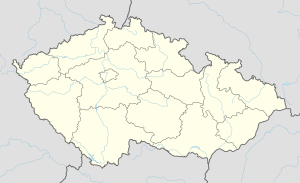Battle of White Mountain
| Battle of White Mountain | |||||||||
|---|---|---|---|---|---|---|---|---|---|
| Part of the Bohemian Revolt during the Thirty Years' War | |||||||||
 Battle of White Mountain, oil painting by P. Snaijers | |||||||||
| |||||||||
| Belligerents | |||||||||
|
|
| ||||||||
| Commanders and leaders | |||||||||
| Strength | |||||||||
|
23,000 12 guns[1] |
21,000 10 guns[1] | ||||||||
| Casualties and losses | |||||||||
| 650 killed and wounded[2] | 2,800 killed and wounded[2] | ||||||||
Location within Prague | |||||||||
The Battle of White Mountain (Czech: Bitva na Bílé hoře; German: Schlacht am Weißen Berg) was an important battle in the early stages of the Thirty Years' War. It led to the defeat of the Bohemian Revolt and ensured Habsburg control for the next three hundred years.
It was fought on 8 November 1620. An army of 21,000 Bohemians and mercenaries under
Prelude
In the early 17th century most of the Bohemian estates, although under the dominion of the predominantly
In 1617, as the health of
Ferdinand (who would become
Particularly galling to Protestants were perceived violations of
In November 1619, Elector Palatine
Battle
This section needs additional citations for verification. (November 2017) |


In 1620, now fully established as emperor, Ferdinand II set out to conquer Bohemia and make an example of the rebels. King Frederick and his military commander, Prince
After conquering most of western Bohemia, the Imperial army made for Prague, the Bohemian capital, then in rebel hands. The Bohemians attempted to block them by setting up defensive positions, which the Imperial army simply bypassed. Force-marching his men, Christian of Anhalt managed to get ahead of the Imperial army just before Prague. He thus gained an advantageous position on the "White Mountain", actually a low plateau, but had little time to set up defensive works. Enthusiasm for joining battle was low on both sides. After the reverses of the previous several weeks, Christian of Anhalt's army had been reduced to about 15,000 men, with little prospect of victory; the mercenaries on both sides had not been paid in months; and with winter approaching, cold wet weather made for less than ideal combat conditions.
On 8 November a small Imperial force was sent to probe the Protestant flank. To their surprise, the Bohemians retreated at their advance. Tilly quickly sent in reinforcements, and the Bohemian flank began to crumble. Anhalt tried to relieve the situation by sending forward infantry and cavalry led by his son
The Bohemian army was no match for the Emperor Ferdinand's troops. The actual battle lasted only an hour and left the Bohemian army in tatters. Some 4,000 Protestants were killed or captured, while Imperial losses amounted to only about 700.[8]
Aftermath

With the Bohemian army destroyed, Tilly entered Prague and the revolt collapsed. King
There remained a strong Protestant army in Silesia under the command of Johann Georg von Brandenburg, Duke of Krnov, which continued fighting the Imperial army in Moravia and in what today is Slovakia until 1623.
In 1621, the Emperor ordered all Calvinists and other non-Lutherans to leave the realm in three days or to convert to Catholicism.
The population in the Lands of the Bohemian Crown declined by about a third until the end of the war.[12]
The result of the 1620 battle brought two centuries of re
See also
References
- ^ a b Wilson 2009, pp. 304, 306.
- ^ a b Wilson 2009, p. 306.
- ^ The Battle of White Mountain, 11-06-2003 – Radio Praguel.
- ^ Johnson, Lonnie. Central Europe enemies, neighbours, friends. New York: Oxford UP, 1996. Print.
- The Thirty Years War: A Documentary History. Indianapolis: Hackett Company, Inc., 2009. Print.
- ^ Guthrie, William P. Battles of the Thirty Years War from White Mountain to Nordlingen, 1618–1635. Westport, CT: Greenwood, 2001. Print.
- ^ "Thinkers at War – Descartes | Military History Matters". 21 March 2014.
- Thirty Years War from White Mountain to Nordlingen, 1618–1635. Westport, CT: Greenwood, 2001. Print. [ISBN missing][page needed]
- ^ Consequences of Czech Defeat, U.S. Library of Congress
- ISBN 978-1365688317.
- ^ Wedgwood, C. V. (1964) [1938]. The Thirty Years War. London: Jonathan Cape. pp. 158, 224.
- ^ Wilson 2009, p. 788.
Sources
- The History of the Thirty Years War by Friedrich Schiller
- ISBN 978-88-903010-1-8)
- ISBN 978-88-903010-2-5)
- Bohemia in history. Cambridge, U.K: Cambridge UP, 1998. Print.
- Helfferich, Tryntje. The Thirty Years War: A Documentary History. Indianapolis: Hackett Company, Inc., 2009. Print.
- Josef V. Polisensky, Thirty Years War, University of California Press (June 1971); La guerra dei trent'anni: da un conflitto locale a una guerra europea nella prima metà del Seicento – Torino: Einaudi, 1982.
- Tomáš Kleisner, Giovanni Pietro de Pomis Medal of the Battle of the White Mountain
- Wilson, Peter H. (2009). Europe's Tragedy: A History of the Thirty Years War. Allen Lane. ISBN 978-0-7139-9592-3.
External links
- Johnson, L. (1996). Central Europe: Enemies, Neighbors, Friends: Enemies, Neighbors, Friends. Oxford University Press, US. ISBN 9780198026075.
- Guthrie, W.P. (2002). Battles of the Thirty Years War: From White Mountain to Nordlingen, 1618–1635. Greenwood Press. ISBN 9780313320286.
- Teich, M. (1998). Bohemia in History. Cambridge University Press. ISBN 9780521431552.
- Helfferich, T. (2009). The Thirty Years War: A Documentary History. Hackett Publishing. ISBN 9781603843638.
- Bellum.cz – "Battle of White Mountain 8th November 1620"
- Kafkadesk.org - "...in 1620: the Bohemian estates were defeated at the Battle of White Mountain"


